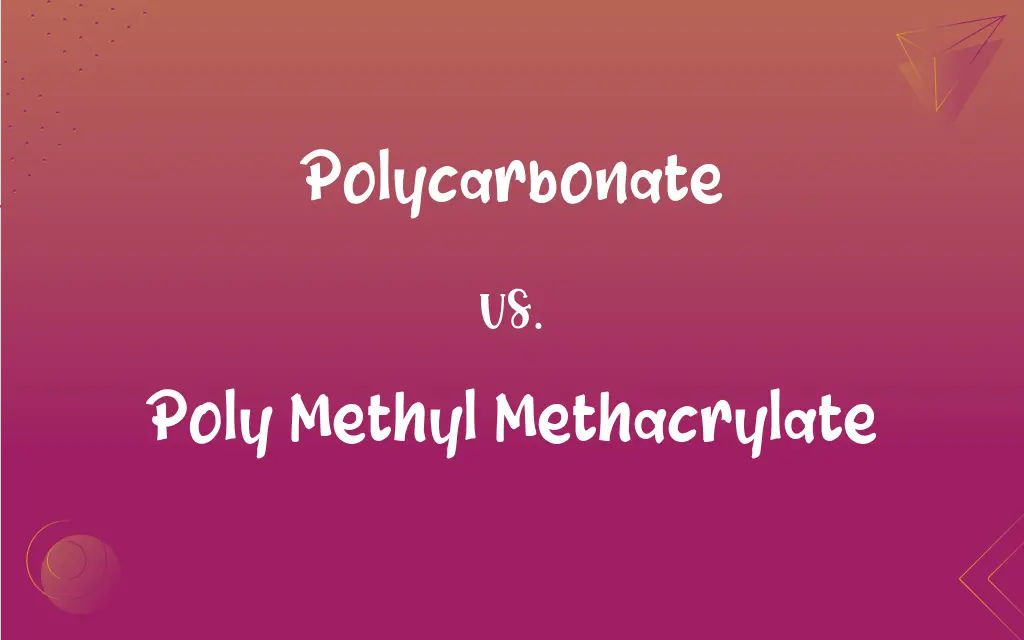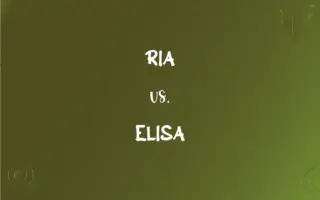Polycarbonate vs. Poly Methyl Methacrylate: What's the Difference?
Edited by Aimie Carlson || By Harlon Moss || Published on March 29, 2024
Polycarbonate is a durable, impact-resistant plastic, while Poly(methyl methacrylate) (PMMA) is a clear, lightweight plastic often used as a glass alternative.

Key Differences
Polycarbonate (PC) is a thermoplastic polymer known for its exceptional strength, toughness, and temperature resistance. It is commonly used in applications requiring high impact resistance and durability, such as in bulletproof glass, eyewear lenses, and various automotive and aerospace parts. Poly(methyl methacrylate) (PMMA), also known as acrylic or acrylic glass, is another thermoplastic with excellent clarity and optical properties, making it an ideal substitute for glass in many applications. PMMA is lighter and has a higher resistance to UV light and weathering compared to glass, which is why it is commonly used in window panes, aquariums, and lenses.
Both polycarbonate and PMMA are plastics with wide-ranging applications, their physical properties dictate their specific uses. Polycarbonate's high impact resistance and thermal stability make it suitable for use in safety and protective equipment, while PMMA's clarity and resistance to UV degradation make it preferable for aesthetic or light-transmitting applications. Despite their differences, both materials are easily moldable, recyclable, and have good chemical resistance, albeit polycarbonate generally offers better resistance to chemicals and temperatures than PMMA.
Polycarbonate also tends to be more expensive than PMMA, reflecting its superior physical properties and the more complex manufacturing process required. The choice between polycarbonate and PMMA often comes down to a trade-off between impact resistance and cost, with polycarbonate being the go-to for more demanding applications and PMMA serving well in situations where optical clarity and aesthetics are prioritized over durability.
Both materials can be produced with various additives to enhance certain properties, such as UV stabilizers, flame retardants, and colorants, further broadening their application scope. As such, engineers and designers must carefully consider the specific requirements of their project when choosing between polycarbonate and PMMA, taking into account factors like impact resistance, optical clarity, cost, and environmental resistance.
Comparison Chart
Impact Resistance
Very high
Moderate
ADVERTISEMENT
Optical Clarity
High clarity, can be made optically clear
Excellent optical clarity, comparable to glass
UV Resistance
Good, but can degrade without UV stabilizers
Excellent, inherently UV resistant
Cost
Generally more expensive
Less expensive compared to polycarbonate
Temperature Resistance
Better, can withstand higher temperatures
Lower temperature resistance
Applications
Bulletproof windows, eyewear, automotive parts
Signage, light fixtures, aquariums
ADVERTISEMENT
Polycarbonate and Poly Methyl Methacrylate Definitions
Polycarbonate
A durable thermoplastic used in impact-resistant products.
The polycarbonate helmet protected the cyclist during the crash.
Poly Methyl Methacrylate
Popular in aquarium and signage applications.
The aquarium's large tanks were made of thick, clear PMMA.
Polycarbonate
Known for its high temperature and impact resistance.
Polycarbonate containers can withstand boiling water without deforming.
Poly Methyl Methacrylate
Can be easily molded and shaped.
The designer created a sleek, curved PMMA chair.
Polycarbonate
Used in safety and protective gear.
Polycarbonate eyewear lenses resist cracking under stress.
Poly Methyl Methacrylate
A clear plastic often used as a glass alternative.
The PMMA skylight panels were lighter than glass and shatter-resistant.
Polycarbonate
Can be transparent or colored for various applications.
The greenhouse used transparent polycarbonate panels for roofing.
Poly Methyl Methacrylate
Features excellent light transmission properties.
The artist chose PMMA sheets for the sculpture to capture the sunlight.
Polycarbonate
Resistant to many chemicals, making it versatile.
Industrial polycarbonate face shields provide chemical splash protection.
Poly Methyl Methacrylate
Known for its UV resistance and durability against weathering.
Outdoor PMMA panels remained clear and unyellowed for years.
Polycarbonate
Any of a group of thermoplastics that are linear polyesters of carbonic acid, especially those derived from bisphenol A and phosgene, characterized by high-impact strength, light weight, and flexibility, and used as shatter-resistant substitutes for glass.
Polycarbonate
(chemistry) Any of a range of polymers of aromatic carbonates; they are used to make light, flexible alternatives to glass. Abbreviation: PC
FAQs
Can polycarbonate be used outdoors?
Yes, especially with UV stabilizers to prevent degradation.
What is polycarbonate mainly used for?
It's used for products requiring high impact resistance and durability.
Is PMMA a good glass substitute?
Yes, due to its clarity and shatter resistance.
Are polycarbonate products recyclable?
Yes, polycarbonate can be recycled.
What makes PMMA popular in design and aesthetics?
Its excellent optical clarity and ability to mimic glass.
What are the environmental considerations for using polycarbonate?
It requires careful disposal or recycling due to potential BPA content.
Can PMMA withstand high temperatures?
It has lower temperature resistance compared to polycarbonate.
How is polycarbonate processed?
It can be molded, extruded, or thermoformed.
Is PMMA UV resistant?
Yes, it has excellent UV resistance.
How does the cost of polycarbonate compare to PMMA?
Polycarbonate is generally more expensive due to its superior properties.
Is polycarbonate chemical resistant?
It has good chemical resistance, but it varies with the chemical.
Can PMMA be used in lighting applications?
Yes, it's often used in light fixtures due to its light diffusing properties.
Can PMMA be colored?
Yes, it can be easily colored during production.
Can polycarbonate be used for bulletproof applications?
Yes, it's used in bulletproof glass due to its high impact resistance.
What are the limitations of PMMA in outdoor applications?
While UV resistant, it's less impact-resistant and can scratch more easily than polycarbonate.
How does PMMA react to impact compared to polycarbonate?
PMMA is more prone to cracking under impact.
How does the weight of PMMA compare to glass?
PMMA is significantly lighter than glass.
How is PMMA commonly fabricated?
Through injection molding, extrusion, and casting.
Is polycarbonate suitable for food contact applications?
Yes, food-grade polycarbonate is used in food containers and utensils.
What advancements have been made in polycarbonate technology?
Developments include improved UV resistance and reduced weight.
About Author
Written by
Harlon MossHarlon is a seasoned quality moderator and accomplished content writer for Difference Wiki. An alumnus of the prestigious University of California, he earned his degree in Computer Science. Leveraging his academic background, Harlon brings a meticulous and informed perspective to his work, ensuring content accuracy and excellence.
Edited by
Aimie CarlsonAimie Carlson, holding a master's degree in English literature, is a fervent English language enthusiast. She lends her writing talents to Difference Wiki, a prominent website that specializes in comparisons, offering readers insightful analyses that both captivate and inform.































































